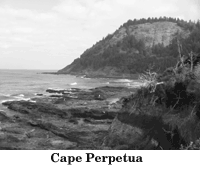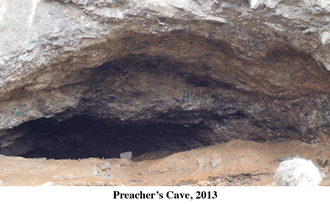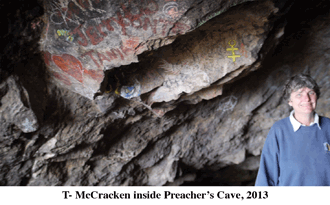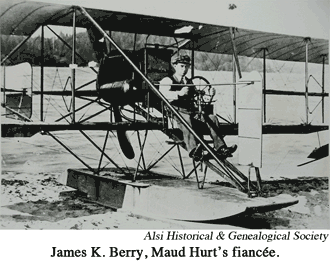The coast was more settled by 1906, but not much more. 1906 was the year Edmund Creffield announced: "I have called down the wrath of an angry God on these modern Sodoms of Seattle, of Portland, of San Francisco, of Corvallis itself." Just days after his announcement, on Wednesday, April 18, 1906, San Francisco was nearly destroyed by an earthquake. Creffield took full credit for the devastation.
Consequently, when he told his followers that they must flee to the coast to establish a new Eden, they obeyed without hesitation. Some couldn't afford the train, so hiked almost seventy miles through the Coast Range Mountains, going through areas heavily populated by bears and cougars. The "road" they hiked was really only usable in the summer. Come one rain, it was a mud road. Come two rains, it was an almost impassable mud road with streams crossing it. Those traveling with empty wagons would haul gravel to help fill in potholes.
Smart travelers on it brought with them a bedroll, an axe, a shovel, and lots of food, and a week before a trip made inquiries about the weather and road conditions. Really smart travelers didn't even bother going from Alsea to the coast by land, but went by boat.
Most of Creffield's flock, though, did go by train--so many, in fact, that personnel on the Corvallis & Eastern Railroad began commenting on the sudden increase in the number of passengers, mostly women, heading for the end of the railroad line, Yaquina City, east of Newport, and the closest train depot to Waldport.
From the Yaquina Bay, Creffield and his flock walked to South Beach, going inland over sand and a corduroy road--a "road" made of fallen trees laid side by side. The fourteen-mile journey from South Beach to Waldport was an arduous trek that took most travelers at least a day, and sometimes two. There were places where during a high tide, travelers had to wait before going on. Hidden sink holes that acted much like quick sand sometimes swallowed horses unfamiliar with coastal routes. In the summer, wagons had a tough time moving through the soft beach sand, and in the winter folks didn't travel unless they had to. Still, the beach was easier to walk on than most inland trails, which were heavily overgrown.
From South Beach the group walked past Seal Rocks and down to the Alsea Bay. The only way to cross the Alsea Bay to Waldport was by ferry. To notify the ferryman that a foot party was waiting to cross, travelers raised a signal flag to half mast. They were at the mercy of the tide. If it was coming in, the crossing took about fifteen minutes. If the tide was going out, travelers had to wait six or more hours until it began coming in again.
Just south of Waldport they had to get around a rock outcropping, Yaquina John Point. Myth is that every ninth wave is low enough that if you are fast, even at high tide, you can run around the point without being swept out to sea.
From Yaquina John Point they walked eight miles to the settlement of Ocean View (now called Yachats), passed the old Indian Agency where the Starrs had once homesteaded, and forded the Yachats River. When the river was swollen, the mail carrier who had the coastal route would swim his horse across and hang onto its tail.
On the south side of the Yachats River the group set up a tent camp under some trees near the beach. If ever there was an Eden, this surely was it. An earlier visitor to the site said: "This is the most beautiful part of the coast. The stream is a clear, pure waterway situated ten miles below Alsea Bay in a very romantic spot. Should this locality ever become of easy access, it will develop into a great resort for health and pleasure seekers."
 There was just one problem with
Creffield's Eden--it was visible from the Hosfords'
homestead. One of the Hosford girls could see the group from
a makeshift spyglass, and could see that some of them were
running around without clothes on. Creffield had told his
flock that God had revealed to him that they were to burn
all their clothing and when they wore clothes they were to
wear "holy wrappers"--cotton bathrobe-like garments that he
had brought with him. While screaming and moaning, all the
women threw all their clothing onto a bonfire.
There was just one problem with
Creffield's Eden--it was visible from the Hosfords'
homestead. One of the Hosford girls could see the group from
a makeshift spyglass, and could see that some of them were
running around without clothes on. Creffield had told his
flock that God had revealed to him that they were to burn
all their clothing and when they wore clothes they were to
wear "holy wrappers"--cotton bathrobe-like garments that he
had brought with him. While screaming and moaning, all the
women threw all their clothing onto a bonfire.
When the Hosford girl told her father what she had seen, he ordered the group, in no uncertain terms, to leave. The group continued south. Three miles after the Yachats River, they had to get around Cape Perpetua, the highest point on the Oregon coast. Locals joked that when the good Lord made Oregon, He found he had too much material on hand, so to get it all in, He had to stand part of it on end.
 The wind sometimes gusted so hard around
the cape that the mail carrier dismounted his horse before
rounding it, fearing that if he didn't, he might be blown
into the ocean. He would tighten his horse's cinches, tie
the stirrups over the saddle, check his mail pouch
fastenings, take off his black sou'west rain slicker, roll
it up, and tie it to the saddle. Then, on his hands and
knees, he would crawl along the trail, a narrow ledge, while
his horse hugged the eight-hundred-foot stone cliff, its
hair scraping the jutting rocks.
The wind sometimes gusted so hard around
the cape that the mail carrier dismounted his horse before
rounding it, fearing that if he didn't, he might be blown
into the ocean. He would tighten his horse's cinches, tie
the stirrups over the saddle, check his mail pouch
fastenings, take off his black sou'west rain slicker, roll
it up, and tie it to the saddle. Then, on his hands and
knees, he would crawl along the trail, a narrow ledge, while
his horse hugged the eight-hundred-foot stone cliff, its
hair scraping the jutting rocks.
Just south of Cape Perpetua was the Devil's Churn where one mail carrier, Art Carpenter, once got his feet out of his stirrups just before his horse plunged to its death. Five miles south of Cape Perpetua, the group set up camp at Cummins Creek. Creffield left them to find a new Eden, but was killed before he could return.
 Weeks after Creffield had left, George
Hodges, a timber cruiser, almost swallowed his chewing
tobacco when he found five thinly clad women camped at
Cummins Creek, one holding a five-month-old baby "A more
secluded place could not be selected," Hodges said.
Weeks after Creffield had left, George
Hodges, a timber cruiser, almost swallowed his chewing
tobacco when he found five thinly clad women camped at
Cummins Creek, one holding a five-month-old baby "A more
secluded place could not be selected," Hodges said.
The women all returned to their homes elsewhere, but within a few years, almost everyone connected with the Holy Rollers moved to Waldport or its vicinity. Creffield's choice of the central Oregon coast for his Eden was appropriate in that most of those who do choose to live there view it as a sort of Eden. Granted, it rains a lot--almost eight-feet-a-year that causes even the most pious to curse the weather on occasion--but to those who love the area, the rain does not detract from its Eden-like-quality. The clouds, even when it's raining, are often rimmed with a brilliant light--it's almost as though part of their silver linings are showing through. And that light glistens off of lush vegetation, vegetation that everyone knows grows so lushly because of the rain, and shines in an almost infinite number of green tints and hues. One can not help but feel that if there is a God, this area was one of His most special creations.
 O.
V. Hurt bought the old Alsea Agency farm that his wife's
family had homesteaded in the settlement of Oceanview. He
paid $7,200, and, shortly after buying it, he sold it to a
London syndicate for $25,000. The town of Oceanview was laid
out on it. Oceanview, a name many other towns with
ocean-views shared, was, at James K. Berry's suggestion,
renamed Yachats.
O.
V. Hurt bought the old Alsea Agency farm that his wife's
family had homesteaded in the settlement of Oceanview. He
paid $7,200, and, shortly after buying it, he sold it to a
London syndicate for $25,000. The town of Oceanview was laid
out on it. Oceanview, a name many other towns with
ocean-views shared, was, at James K. Berry's suggestion,
renamed Yachats.
Mae Hurt, Creffield's sister-in-law and one of his youngest followers, married a man named Frank Johnson and they ran a hotel in Yachats. The hotel had been owned by John Silvers, a big fellow with big ideas, who sold part of Yachats, although he didn't own an inch. He "salted" a gold mine in town, but his gold ran out and so did he--leaving almost as fast as Creffield had.
Many visitors came to the coast for their health. In 1837 two missionaries from the Willamette Valley brought their new brides to honeymoon there and to recuperate from a bout of malaria. Over the years, others followed, believing that the climate was good for treating various ailments, including fevers and ague. Visitors surf bathed while wearing long woolen bathing costumes.
"Locally, the rains are not heavy, are never violent, and there are no storms," pamphlets passed out by the Southern Pacific Railroad said. "There are no winter fogs, and much winter sunshine makes for comfort as well as the growth of grass and plants." The pamphlet said the climate on the Oregon coast was comparable to that on the Mediterranean in Italy and France. Preachers weren't the only ones who tinkered with the truth. The area, a temperate rain forest, usually has eight feet of rain per year.
What may have helped the ailing more than the weather was the availability of alcohol. The temperance movement succeeded in "drying" up the Willamette Valley for a time, causing many came to the coast with empty grips that were filled when they returned home.
Waldport, Oregon, the setting for the final chapter of Creffield's story, was also the setting for the first chapter of another cult story, Heaven's Gate
Waldport History Part 2
Waldport History Part 3
For Further Information:
Fagan, David D. History of Benton County, Oregon. 1885.
Hayes, Marjorie H. The Land That Kept Its Promise, (A History of South Lincoln County). Lincoln County Historical Society, Newport, OR. Copyright 1976, Third Printing, January 1991.
Kent, Eugene. The Siletz Indian Reservation 1855-1900. Portland State University. Portland, OR. 1973.
Lincoln County Extension Office. Lincoln County Histories. Newport, Oregon. 1976.
Price, Richard L. Newport, Oregon. 1866-1936. Lincoln County Historical Society, Newport. 1975.
Beckman, Stephen Dow. "Federal-Indian Relations," The First Oregonians. Oregon Council for the Humanities, Portland, Oregon. 1991.
Yunker, Susanna Beck . Proved Up On Ten Mile Creek, The Story of the Early Settlers of Ten Mile Creek Lane County, Oregon. 1991.
Chapters from
Holy Rollers: Murder & Madness in Oregon's Love Cult
Part 1: The Seduction
Chapter 1: Trust Me, Brothers And Sisters
(Life Before Creffield [B.C.])
Chapter 2: God, Save Us From Compromising Preachers
(Creffield's Preachings)
Chapter 3: The Flock
(Profiles of the Holy Rollers Were)
Chapter 4: The Holy Rollers
(Things Start to Get Wild on on Kiger Island)
Chapter 5: Housecleaning
(There's a Sacrificial Bonfire)
Chapter 6: Community Concerns
(Officers Visit)
Chapter 7: Esther, The Chosen One
(Creffield Plans to Marry 16-Year- Old)
Chapter 8: Tar and Feathers
(The Men of Corvallis Act)
Chapter 9: Sane People Don�t Go Bareheaded
(Holy Rollers are Committed to the Asylum)
Chapter 10: More Beast Than Man
( Creffield is Arrested)
Chapter 11: God Will Plead Creffield's Case
(Creffield in Court)
Chapter 12: Scandal
(Shocking Testimony at the Trial)
Chapter 13: Calm Before the Storm
(The Holy Rollers Resume their Lives)
Chapter 14: Giving Up The Ghost
(Men are Gunning for Creffield)
Part Two: The People V. Creffield
Chapter 16: The Widow Creffield
Chapter 19: An Inherited Streak of Insanity
Part Three: The Madness
Chapter 23: Seeking Reconciliation
Chapter 24: Another Holy Roller Page One Murder
Chapter 25: What Can Papa Do For You?
Chapter 26: Human Life is Too Cheap In This Community
Chapter 30: The Final Chapter
(What Happened to Everyone Afterwards)
The Epilogue
(Heaven's Gate)
Chapter of Holy Rollers where much of the action takes place in Waldport
Chapter 14: Men are Gunning for Creffield
